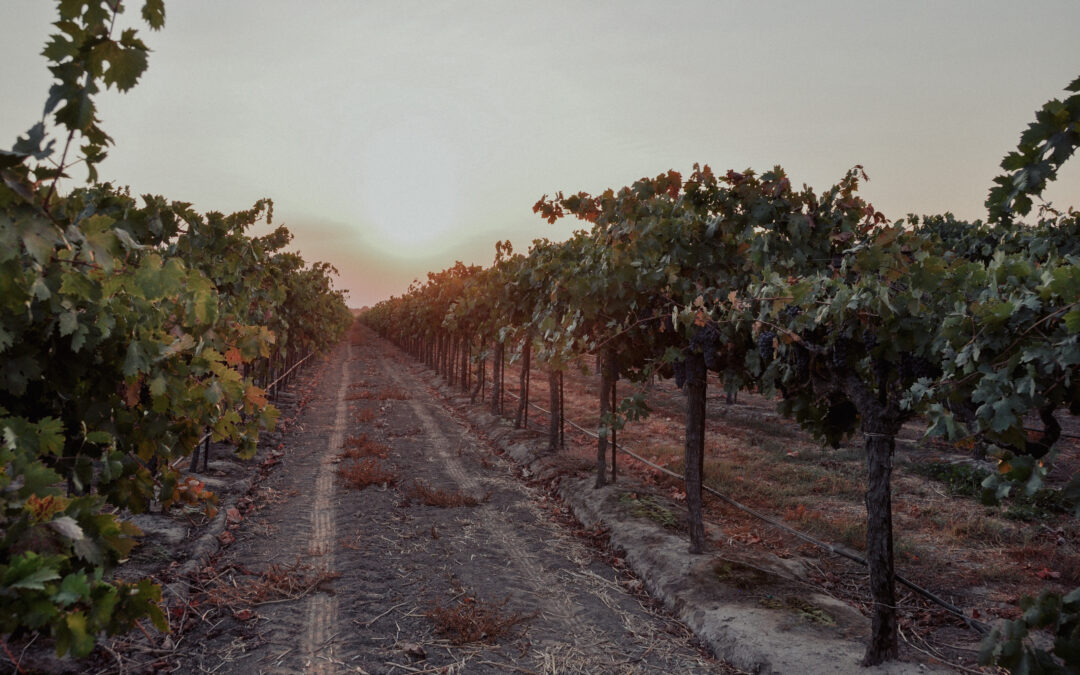MONDAY, SEPTEMBER 19, 2022. BY STAN GRANT, VITICULTURIST.
In vineyards, some problems develop fast, like powdery mildew epidemics and heat stress. These become apparent within days after initiation. Other problems are more insidious, slowly revealing themselves over months or years as their effects gradually become apparent. Soil compaction is among these. It slowly robs grapevines of growth and production capacity, and ultimately their health. Soil compaction is among the factors limiting vineyard longevity.
Characteristics and Effects of Soil Compaction
Compacted soils have bulk densities greater than about 1.1 to 1.6 g/cm3 (clayey to sandy soils, respectively), few pores (i.e. low total porosity), a high level of discontinuity between pores that restrict aeration, and a small average pore size that obstructs root elongation and drainage. Compacted soil surfaces impair water infiltration and at the same time, accelerate surface runoff and associated topsoil erosion. Soil compaction under the surface diminishes soil water holding capacity, inhibits soil microbe populations and their activities, limits mineral nutrient movement towards roots, heightens the risk of stresses in vines, reduces vine and cover crop growth vigor, and decreases grape yields. Obviously, soil compaction is costly.
A soil pore must be the same size as a root cap or larger for a root to extend through it unencumbered. Compacted soils have a limited number of such pores. To extend into smaller pores, roots must displace soil particles. The maximum pressure roots can exert in these efforts is about 350 pounds per square inch (PSI). If the resistance of soil in front of an advancing root tip is stronger than this threshold pressure, the root must change course or cease growing. Actually, in highly compacted soils roots are largely limited to cracks and cleavage planes.
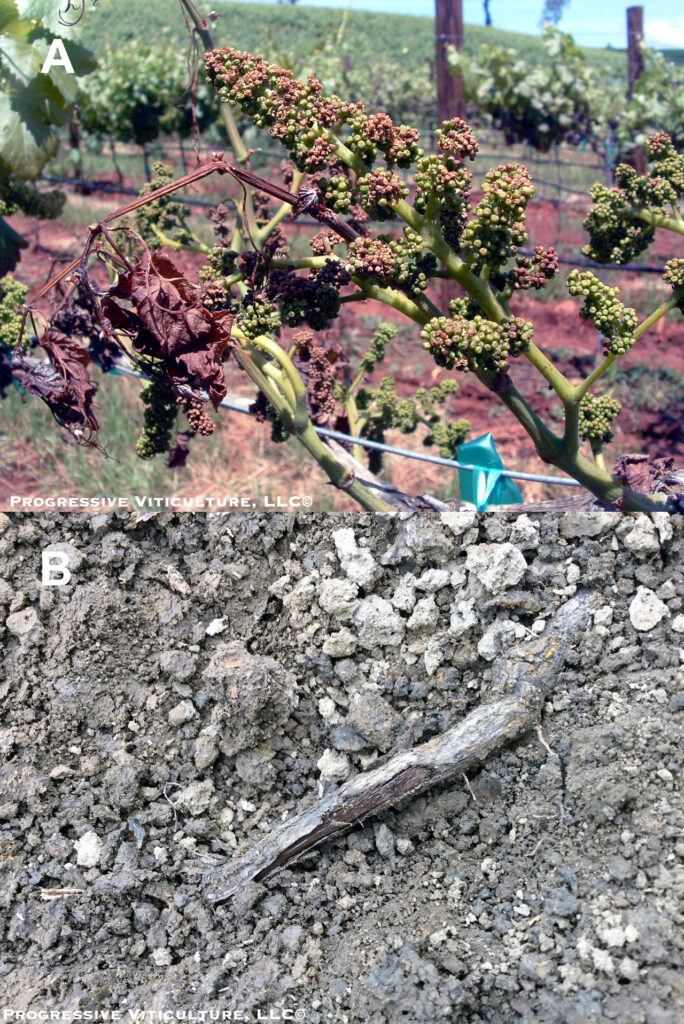
Figure 1. Collapsed shoots and dying flowers (A), and darkened vascular tissues in roots (B) are among the symptoms of excessive root zone moisture and insufficient aeration. (Photo Source: Progressive Viticulture, LLC©)
The suboptimal environment within compacted soils, often with excessive water and limited air, is a compounding impediment to root activity and growth, as well as overall vine growth and productivity. Plant growth is restricted when soils have an air-filled porosity of less than about 10% of the total porosity at field capacity. Under these conditions, oxygen diffusion towards roots is limited, and harmful carbon dioxide and ethylene can build up. Such an environment increases vine susceptibility to root diseases and may be a contributing factor to the malady currently called sudden vine collapse (Figure 1).

Figure 2. A penetrometer is an instrument for assessing soil compaction. (Photo Source: W. W. Grainger, Inc.)
Of the negative effects listed above, those most telling for vineyard managers monitoring their vineyards for soil compaction are slow water infiltration, restricted cover crop and vine growth, and collapsed vines. The degree of soil compaction can also be assessed using a penetrometer. A penetrometer, which is also known as a compaction tester, is an instrument consisting of a narrow, graduated shaft with a point on one end for soil insertion and a pressure gauge on the other attached to handles for applying pressing on the tip (Figure 2). Penetrometer readings ought to be well below 300 PSI.
Soil Compaction Occurrence and Causes
Soils are compact when compressive forces act upon them. Compaction may be naturally occurring. For example, soil surfaces exposed to the pounding and dispersing actions of raindrops become compact and surface crusts form after they dry.
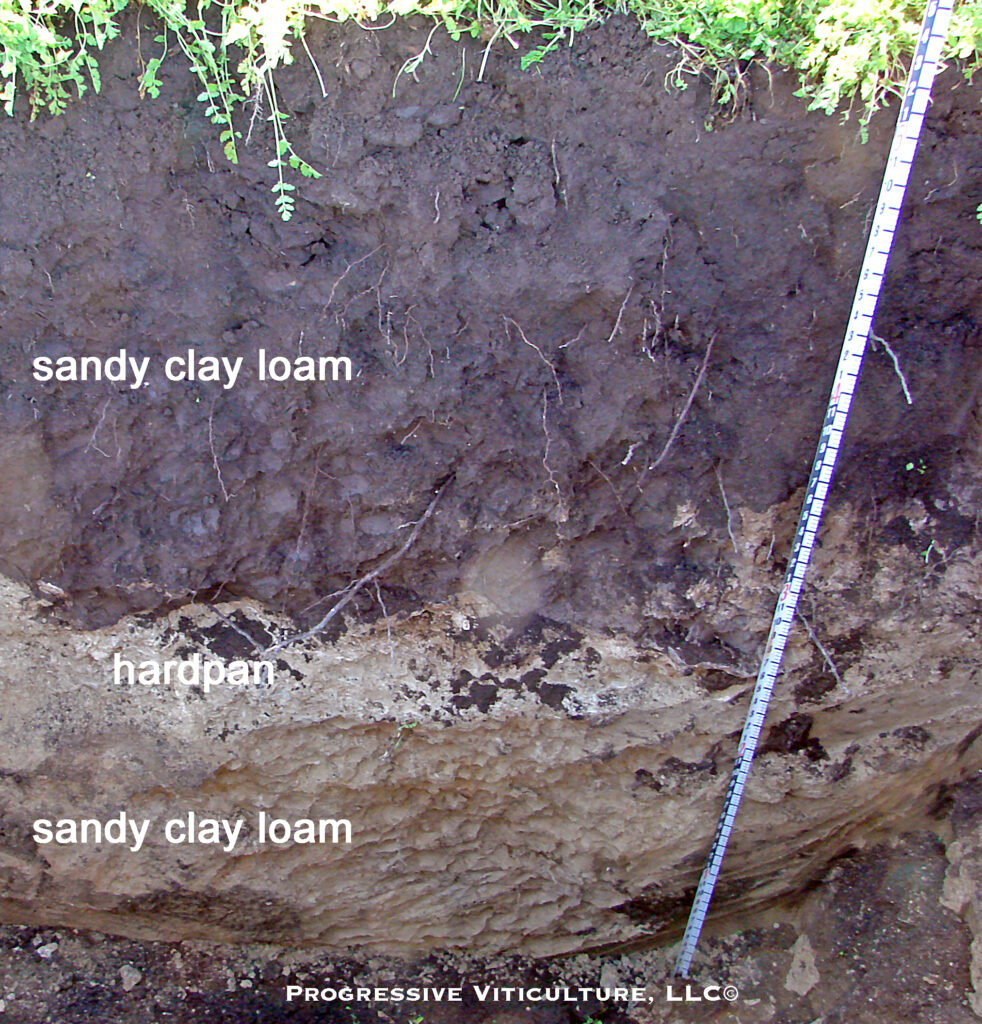
Figure 3. A soil profile that includes a subsoil hardpan layer. Lodi, California. (Photo Source: Progressive Viticulture, LLC©)
Hardpans consisting of densely packed mineral particles naturally occur in some subsoils. These functionally impervious layers form under pressure, usually at the interface between two markedly different soil layers (Figure 3). The most extreme of hardpans (fragipans) have rock-like characteristics.
Claypans are another type of very slowly pervious, compact subsoil layer that consists of clay particles with minimal aggregation. Claypan density intensifies as they dry and shrink. Surface crusts, hardpans, and claypans occur, to some extent, in most California winegrape growing regions.
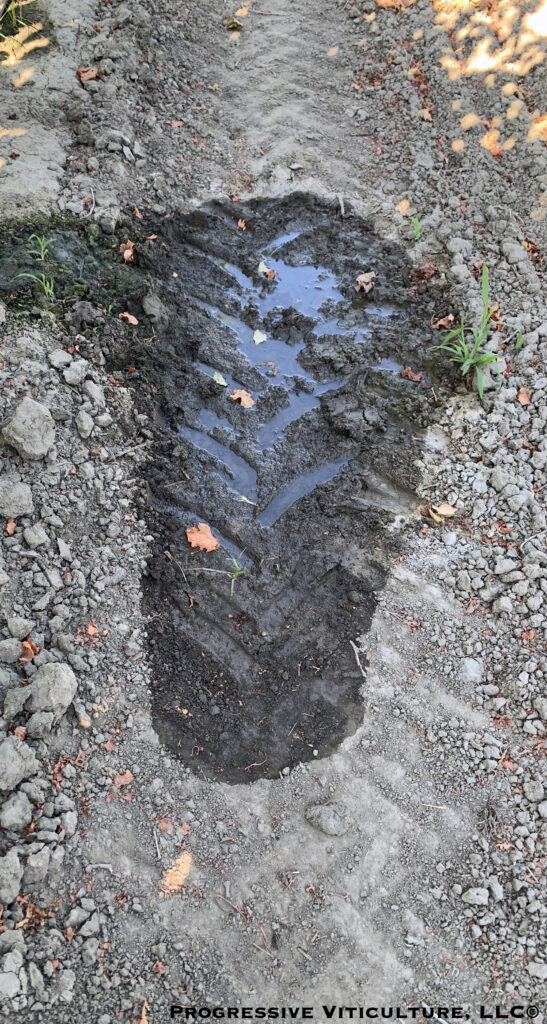
Figure 4. Soil compaction is evident as tire tread marks and impaired water infiltration. Sacramento River Delta, California. (Photo Source: Progressive Viticulture, LLC©)
Soils may also become compacted artificially. The trampling of livestock is the oldest mode of soil compaction associated with agriculture. In vineyards, mechanized equipment traffic is the primary source of compaction (Figure 4).
All types of machinery compact soils to some degree. Tractors compact soils due to the downward compressive forces of their weight in combination with the shearing forces and kneading actions of their turning tires or tracks. Under some circumstances, the churning action of slipping wheels can actually be more damaging to soil structure and porosity than equipment weight. Tillage implements further deform and restructure soils through cutting, lifting, displacing, and mixing. For very sandy soils, machine vibration is an effective compressive force.
Soil Compaction Factors
Compaction intensity depends on soil conditions as well as the characteristics of the compacting agent. A soil’s resistance to compaction substantially increases with its organic matter content. Soil compactibility increases with moisture content up to field capacity and then decreases as wetness approaches saturation. Many clayey soils are especially susceptible to compaction during cultivation when wet and very sandy soils with angular particles can become tightly compact.
Managing Soil Compaction
There are two components to managing soil compaction. The first is minimization.
Grow a cover crop and manage it to maximize root growth and humus build-up in the soil, and correspondingly its resistance to compaction. Use equipment with even weight distribution and the lightest footprint befitting the task, adjust tire air pressure to the lowest feasible level, utilize crawler or 4-wheel drive tractors to maximize traction per unit weight, enter the vineyard with equipment only when the soil is sufficiently dry (i.e. well below field capacity in the surface soil), and limit the number of equipment passes through a vineyard to only those that are essential. The latter applies especially to tillage passes.
Fortunately, technologies and practices such as drip irrigation, herbicides, and multi-year cover crops minimize the need for tillage. When tillage becomes necessary, power take-off (PTO) driven cultivators, which produce less tractor tire slippage than drawbar-dependent implements, are alternatives for limiting compaction on highly susceptible soils.
Even with the best minimization efforts, some amount of compaction is inevitable and it will compound over time to the point where harmful effects become visible. This brings us to the second component of compaction management – remediation.
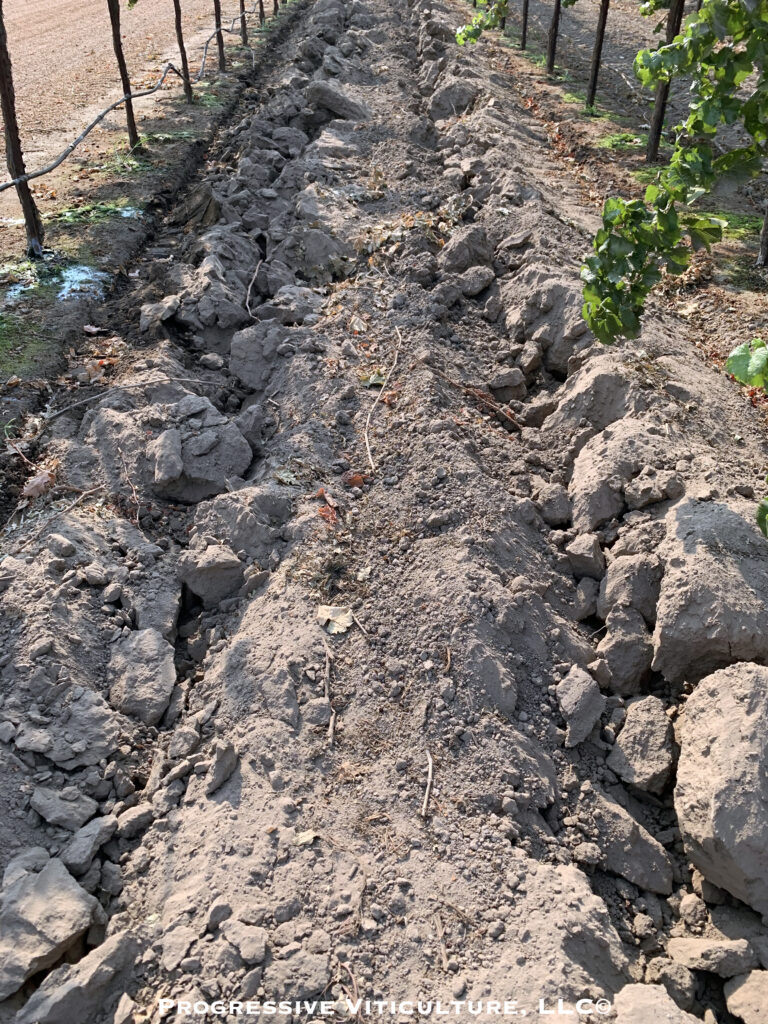
Figure 5. Sandy loam ripped after harvest adjacent to vine rows to mitigate soil compaction. Lodi, California. (Photo Source: Progressive Viticulture, LLC©)
The remedy is periodic chiseling or shallow ripping to below the depth of compaction (commonly 18 to 24 inches) in every other tractor row during the autumn when the soil is dry and shattering is greatest (Figure 5). In this process, some grapevine roots will be pruned and accumulate on the leading edges of the implement shanks. While visually distressing, pruned roots readily regenerate and branch to form a denser root system, which helps vines recover from the adverse effects of compaction and become more resilient to stress.
To Summarize
Soils are fragile and easily compressed, densified, and restructured under pressure and other forces. The negative effects of compaction stealthily creep into vineyards while we are busy with other matters, depriving vineyards of optimum performance and profitability. They are, to some extent, unavoidable given mechanical operations are integral to modern viticulture, but careful vineyard managers work to minimize and as needed, alleviate compaction. In so doing, they advance the health of their vines, promote the uniformity of their vineyards, and foster sustained production of economically viable yields of high-quality fruit.
A version of this article was originally published in the Mid Valley Agricultural Services September 2012 newsletter and was updated for this blog post.
Further Reading
Bettiga, LJ, and Browne, GT. Phytophthora crown and root roots. In Grape pest management. 3rd Ed. Bettiga, LJ (ed.). University of California Agricultural and Natural Resources Publication 3343. pp. 131-132. 2013.
Chancellor, WJ. Compaction of soil by agricultural equipment. University of California Division of Agricultural Sciences Bulletin 1881. 1976.
Correa, J, Postama, J, Watt, M, and Wojciechowski, T. Soil compaction and the architectural plasticity of root systems. Journal of Experimental Botany. 70, 6019-6034. 2019.
Fee, R. Soil penetrometers: probing for compaction. Successful Farming. Meredith Corporation, St. Paul, MN. 2005.
Grant, S. There is more to vineyard floors. Lodi Winegrape Commission Coffee Shop. (lodigrowers.com). March 28, 2022.
Grant, S. The ultimate goal of vineyard soil management: optimized root zone function. Lodi Winegrape Commission Coffee Shop. (lodigrowers.com). December 20, 2021.
Hillel, D. Introduction to soil physics. Academic Press, New York. 1982.
Hoorman, JJ, de Moraes Sa, JC, and Reeder, R. The biology of soil compaction. Crops and Soil magazine. American Society of Agronomy, Madison, WI. July-Aug 2011.
Jensen, T. Subsurface soil compaction restricts rooting depth and access to nutrients and moistures. Plant Nutrition Today. International Plant Nutrition Institute, Norcross, GA. 2018
Jones, D, and Kunze, M. Guide for sampling soil compaction using hand-held soil penetrometers. Center for Environmental Management of Military Lands (CEMML). Colorado State University, Fort Collins. 2004.
McCarthy, MG, Dry, PR, Hayes, PF, and Davidson, DM. Soil management and frost control. In Viticulture: Volume 2 Practices. Coombe, B; Dry, PR (ed.). Winetitles, Adelaide. pp. 148-177. 1992.
Snyder, CS. Soil compaction – agronomic and environmental foe. Plant Nutrition Today. International Plant Nutrition Institute, Norcross, GA. 2008.
van Huyssteen L. Grapevine root growth in response to tillage and root pruning practices. In The Grapevine Root and Its Environment. JL Van Zyl (ed.). Department of Agriculture and Water Supply, Pretoria, South Africa. pp. 44-56. 1988.
Wolkowski, RP, and Bundy, LG. Compaction reduces alfalfa yield. Fluid Journal. Late Spring, 1993.
Have something interesting to say? Consider writing a guest blog article!
To subscribe to the Coffee Shop Blog, send an email to stephanie@lodiwine.com with the subject “blog subscribe.”
To join the Lodi Growers email list, send an email to stephanie@lodiwine.com with the subject “grower email subscribe.”
To receive Lodi Grower news and event promotions by mail, send your contact information to stephanie@lodiwine.com or call 209.367.4727.
For more information on the wines of Lodi, visit the Lodi Winegrape Commission’s consumer website, lodiwine.com.
For more information on the LODI RULES Sustainable Winegrowing Program, visit lodigrowers.com/standards or lodirules.org.

